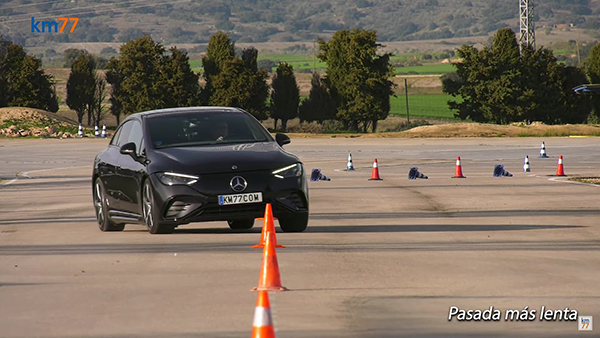Mercedes-Benz opened the gates of its electrification with the EQS and EQE models two years ago, and the electron-powered vehicles garnered praise and criticism alike. Sleek, silent, stylish, sophisticated, and select, the EQE – like all BEVs – is, first and foremost, an automobile.
Mercedes-Benz EQE – Maniobra de esquiva (moose test) y eslalon
That utmost mechanical lineage should be enough reason to cancel all eco-friendly pedestals on which the allegedly non-polluting cars of the same species are raised. A car is meant to be driven on the same roads as they have been for the past 130 years, regardless of its drivetrains and fuel types.
Roads, however, become increasingly crowded each year, and carmakers adapt to this situation by constantly improving their products. Driver aids are industry must-haves, rather than technological breakthroughs offered as optional extras, and conjugate to make the ride safer.
As such, even the electric automobile must comply with the indiscriminating reality of driving in the third millennium. After all, going from point A to B can be as simple as a straight line or as intricate as swerving from geometry in favor of other factors, like efficiency, speed, or safety.
Regarding the latter element, one vital aspect of driving is doing it incident-free. Today’s cars have a Yellow Pages-sized list of safety features, but the crucial part is still the driver’s awareness.
Of course, an automobile’s behavior also helps tremendously in times of need, and a great-performing car is always a good idea. The industry has devised countless tests to make the car safer. Still, one particular assessment speaks volumes about a vehicle’s ability to safeguard its occupants.
Colloquially known as The Moose Test, this trial examines an automobile’s response to a sudden change in trajectory at a relatively high speed. The maneuver originated in Sweden, where occasional encounters between motorists and moose inspired Volvo to put its cars through similar simulated situations.
That was decades ago, and today the Moose Test is a good indicator of a car’s handling, braking, recovery ability, steering, and several other aspects. This test can make or break an acquisition from a potential customer’s point of view.
The Mercedes EQE is no exception, and its triple aura of “German,” “Electric,” and “Mercedes” is positively null in this instance. If it fails, it’s as good as its older, smaller-category sibling A-Class from 26 years ago (refer to the second video for details).

However, Mercedes have learned plenty from their epic fail of 1997, and the company’s models got proportionally better at cervid avoidance. The EQE obeys the trend, and the Spaniards from km77 demonstrate this claim with their test version.
The model is the EQE 350+, the 2.3-ton rear-wheel drive electric equivalent of the E-Class. With the best Pirelli rubbers (custom-fabricated to meet Mercedes’ requirements), the 288-hp (292 PS) sedan leaves a good (but not excellent) impression on the team of auto journalists.
km77.com deems a moose test pass success only if the entry speed is at least 77 kph (48 mph) and the course-delimiting cones are still in place at the end. The EQE does not meet the standard in this regard, only besting a 74 kph initial speed (46 mph).
The car’s momentum is beyond the computerized ability of the vehicle to steer clear and then return to the initial path. The drivers feel that the stability control system is very discrete – either not kicking in early enough or not pulling the reins hard enough when correcting the trajectory.
The best successful attempt shows a well-balanced EQE that doesn’t bat an eyelid through the evasive maneuver. Also, in the car’s defense, the 77-kph (48 mph) test shows only a slight hesitation on the exit when the Merc gently brushes off a cone but without flipping it over.
To practically demonstrate just how great of an impact a slight increase in speed has on a car’s handling and steering response, the 79-kph test (49 mph) has the 2023 Mercedes EQE 350+ headbutting cones with a physics-backed frenzy. Less than one mph faster, the car already begins to become uncontrollable.
Whether this testing session is relevant to buyers is a matter of individual preference. Still, the EQE is pretty good at waltzing between obstacles (and the slalom time proves it). And, if you’re wondering where an electric car is likely to encounter a moose, given the limited sprawl of charging stations outside metropolitan areas, remember that the electric Merc’s range is 633 km (393 miles).